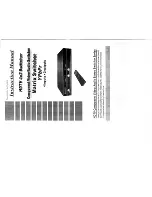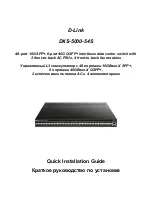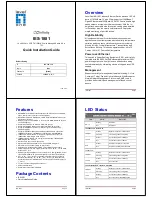
Introduction to Gratuitous ARP
197
Table 165 describes the APR mapping table fields.
ARP Implementation
Procedure
The ARP mapping table of a host is empty when the host is just started up. And when
a dynamic ARP mapping entry is not in use for a specified period of time, it is removed
from the ARP mapping table so as to save the memory space and shorten the interval
for the switch to look up entries in the ARP mapping table.
■
Suppose there are two hosts on the same network segment: Host A and Host B.
The IP address of Host A is IP_A and that of Host B is IP_B. To send a packet to
Host B, Host A checks its own ARP mapping table first to see if the ARP entry
corresponding to IP_B exists. If yes, Host A encapsulates the IP packet into a frame
with the MAC address of Host B inserted to it and sends it to Host B.
■
If the corresponding MAC address is not found in the ARP mapping table, Host A
adds the packet in the transmission queue, creates an ARP request packet and
broadcasts it throughout the Ethernet. As mentioned earlier, the ARP request
packet contains the IP address of Host B, the IP address of Host A, and the MAC
address of Host A. Since the ARP request packet is broadcasted, all hosts on the
network segment can receive it. However, only the requested host (namely, Host B)
processes the request.
■
Host B appends the IP address and the MAC address carried in the request packet
(that is, the IP address and the MAC address of the sender, Host A) to its ARP
mapping table and then sends a ARP reply packet to the sender (Host A), with its
MAC address inserted to the packet. Note that the ARP reply packet is a unicast
packet instead of a broadcasted packet.
■
Upon receiving the ARP reply packet, Host A extracts the IP address and the
corresponding MAC address of Host B from the packet, adds them to its ARP
mapping table, and then transmits all the packets in the queue with their
destination being Host B.
Normally, ARP performs address resolution automatically, without the intervention of
the administrator.
Introduction to
Gratuitous ARP
The following are the characteristics of gratuitous ARP packets:
■
Both source and destination IP addresses carried in a gratuitous ARP packet are the
local addresses, and the source MAC address carried in it is the local MAC
addresses.
■
If a device finds that the IP addresses carried in a received gratuitous packet
conflict with those of its own, it returns an ARP response to the sending device to
notify of the IP address conflict.
Table 165
Description on the fields of an ARP table
Field
Description
IF index
Index of the physical interface/port on the device owning the
physical address and IP address contained in the entry
Physical address
Physical address of the device, that is, the MAC address
IP address
IP address of the device
Type
Entry type, which can be:
1: An entry falling out of the following three cases
2: Invalid entry
3: Dynamic entry
4: Static entry
Summary of Contents for 3CR17660-91
Page 10: ...8 CONTENTS ...
Page 14: ...4 ABOUT THIS GUIDE ...
Page 46: ...32 CHAPTER 5 LOGGING IN THROUGH WEB BASED NETWORK MANAGEMENT SYSTEM ...
Page 48: ...34 CHAPTER 6 LOGGING IN THROUGH NMS ...
Page 60: ...46 CHAPTER 9 VLAN CONFIGURATION ...
Page 64: ...50 CHAPTER 10 MANAGEMENT VLAN CONFIGURATION ...
Page 80: ...66 CHAPTER 13 GVRP CONFIGURATION ...
Page 98: ...84 CHAPTER 15 LINK AGGREGATION CONFIGURATION ...
Page 112: ...98 CHAPTER 18 MAC ADDRESS TABLE MANAGEMENT ...
Page 126: ...112 CHAPTER 19 LOGGING IN THROUGH TELNET ...
Page 162: ...148 CHAPTER 20 MSTP CONFIGURATION ...
Page 274: ...260 CHAPTER 29 IGMP SNOOPING CONFIGURATION ...
Page 276: ...262 CHAPTER 30 ROUTING PORT JOIN TO MULTICAST GROUP CONFIGURATION ...
Page 298: ...284 CHAPTER 33 SNMP CONFIGURATION ...
Page 304: ...290 CHAPTER 34 RMON CONFIGURATION ...
Page 338: ...324 CHAPTER 36 SSH TERMINAL SERVICES ...
Page 356: ...342 CHAPTER 38 FTP AND TFTP CONFIGURATION ...
Page 365: ...Information Center Configuration Example 351 S4200G terminal logging ...
Page 366: ...352 CHAPTER 39 INFORMATION CENTER ...
Page 378: ...364 CHAPTER 40 BOOTROM AND HOST SOFTWARE LOADING ...
Page 384: ...370 CHAPTER 41 Basic System Configuration and Debugging ...
Page 388: ...374 CHAPTER 43 NETWORK CONNECTIVITY TEST ...
Page 406: ...392 CHAPTER 45 CONFIGURATION OF NEWLY ADDED CLUSTER FUNCTIONS ...
















































